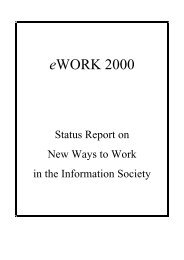Proceedings of 8th European Assembly on telework (Telework2001)
Proceedings of 8th European Assembly on telework (Telework2001)
Proceedings of 8th European Assembly on telework (Telework2001)
Create successful ePaper yourself
Turn your PDF publications into a flip-book with our unique Google optimized e-Paper software.
188Not unexpectedly, this rather big jump from what was generally a single enterprise strategy andto whole industries proved difficult to achieve. Few viable branch programs emerged. What didemerge, however, was a growing number <str<strong>on</strong>g>of</str<strong>on</strong>g> smaller networks: typically five to ten enterprisesjoining forces to improve <strong>on</strong> themes like training and competence development, productivity,product development, quality c<strong>on</strong>trol and similar. The networks were generally <str<strong>on</strong>g>of</str<strong>on</strong>g> modest “mass”but they allowed for c<strong>on</strong>crete co-operati<strong>on</strong> between the participating enterprises.As a c<strong>on</strong>sequence <str<strong>on</strong>g>of</str<strong>on</strong>g> its intenti<strong>on</strong> to actively mobilise research to support the agreement, the labourmarket parties initiated – in the early 1990s – a program for this purpose, in co-operati<strong>on</strong> withthe Research Council <str<strong>on</strong>g>of</str<strong>on</strong>g> Norway and the State Fund for Ec<strong>on</strong>omic and Regi<strong>on</strong>al Development.Called “Enterprise Development 2000” a main functi<strong>on</strong> <str<strong>on</strong>g>of</str<strong>on</strong>g> this program was to extend the linksand ties between enterprises, between enterprises and research, between enterprises and otherrelevant actors, <str<strong>on</strong>g>of</str<strong>on</strong>g>ten regi<strong>on</strong>al <strong>on</strong>es, including the regi<strong>on</strong>al representatives <str<strong>on</strong>g>of</str<strong>on</strong>g> the labour marketparties themselves. In interviews c<strong>on</strong>ducted with the enterprises <strong>on</strong> behalf <str<strong>on</strong>g>of</str<strong>on</strong>g> an internati<strong>on</strong>albenchmarking group – with members from Sweden, Finland, The UK, Germany and France – theenterprise representatives themselves stress this linking functi<strong>on</strong> as a core <strong>on</strong>e. They also generallyreport positive effects <strong>on</strong> productivity and innovative capacity but in a sense these results aretaken more to dem<strong>on</strong>strate the force <str<strong>on</strong>g>of</str<strong>on</strong>g> the co-operati<strong>on</strong> than to be excepti<strong>on</strong>al in their own right(Gustavsen et al 2001)In the third phase <str<strong>on</strong>g>of</str<strong>on</strong>g> the unfolding <str<strong>on</strong>g>of</str<strong>on</strong>g> the agreement <strong>on</strong> development – a new program called ValueCreati<strong>on</strong> 2010 – the major new step is to strengthen the regi<strong>on</strong>al development coaliti<strong>on</strong>s. (Thenoti<strong>on</strong> <str<strong>on</strong>g>of</str<strong>on</strong>g> “development coaliti<strong>on</strong>” corresp<strong>on</strong>ds roughly to the c<strong>on</strong>cept <str<strong>on</strong>g>of</str<strong>on</strong>g> “partnership” which, inturn, is <str<strong>on</strong>g>of</str<strong>on</strong>g>ten identical to the co-ordinati<strong>on</strong> roles in innovati<strong>on</strong> systems). The point is to strengthenthe degree <str<strong>on</strong>g>of</str<strong>on</strong>g> interacti<strong>on</strong>, in particular between the actors in the public support apparatus, with aview to promoting development processes <strong>on</strong> a regi<strong>on</strong>al level, alternatively an industry level. Inthis way Norway moves al<strong>on</strong>g the same trajectory as many other <str<strong>on</strong>g>European</str<strong>on</strong>g> countries and eventhe policies <str<strong>on</strong>g>of</str<strong>on</strong>g> the <str<strong>on</strong>g>European</str<strong>on</strong>g> Uni<strong>on</strong> itself where the regi<strong>on</strong>al plays a major role. Although anykind <str<strong>on</strong>g>of</str<strong>on</strong>g> “regi<strong>on</strong>” in Norway will be thinly populated compared to the <str<strong>on</strong>g>European</str<strong>on</strong>g> averages – infact, the whole ec<strong>on</strong>omy is comparable to a regi<strong>on</strong>al <strong>on</strong>e as much as a nati<strong>on</strong> state ec<strong>on</strong>omy –a regi<strong>on</strong>alisati<strong>on</strong> <str<strong>on</strong>g>of</str<strong>on</strong>g> ec<strong>on</strong>omic development is n<strong>on</strong>etheless important in Norway. The reas<strong>on</strong> isjust that enterprises are thin <strong>on</strong> the ground and that it is, for this reas<strong>on</strong>, extremely difficult tocreate networks or other forms <str<strong>on</strong>g>of</str<strong>on</strong>g> co-operati<strong>on</strong> <strong>on</strong> industry- or branch basis: there will simplynot be a sufficient number <str<strong>on</strong>g>of</str<strong>on</strong>g> enterprises available with a comm<strong>on</strong> industry background withineach separate local c<strong>on</strong>text. For the Norwegian ec<strong>on</strong>omy to reap the benefits <str<strong>on</strong>g>of</str<strong>on</strong>g> networking,co-operati<strong>on</strong> across industries is called for. To organise this kind <str<strong>on</strong>g>of</str<strong>on</strong>g> co-operati<strong>on</strong> there is <str<strong>on</strong>g>of</str<strong>on</strong>g>ten aneed for regi<strong>on</strong>al actors.“The terrain between organisati<strong>on</strong>s” is growing in mass and complexity. If we look at theNorwegian scene in terms <str<strong>on</strong>g>of</str<strong>on</strong>g> the noti<strong>on</strong> <str<strong>on</strong>g>of</str<strong>on</strong>g> innovati<strong>on</strong> system what we find at the moment is alarge number <str<strong>on</strong>g>of</str<strong>on</strong>g> initiatives. Enterprise networks, technology centres, business centres, innovati<strong>on</strong>parks, clusters, even efforts at creating “industrial districts” and “learning regi<strong>on</strong>s” are appearingby the numbers. Excepting a few co-operati<strong>on</strong> schemes in the oil and gas sector all are, however,small. One <str<strong>on</strong>g>of</str<strong>on</strong>g> the few “nati<strong>on</strong>al initiatives” to promote innovati<strong>on</strong> pertains to the microelectr<strong>on</strong>icsindustry, with a main focus <strong>on</strong> a network <str<strong>on</strong>g>of</str<strong>on</strong>g> 45 enterprises located in the same regi<strong>on</strong>, referred toas “Electr<strong>on</strong>ic Coast”. The sum total <str<strong>on</strong>g>of</str<strong>on</strong>g> workplaces involved in this nati<strong>on</strong>al initiative is, however,barely above 2000, which tells a lot about the scale <str<strong>on</strong>g>of</str<strong>on</strong>g> innovati<strong>on</strong> initiatives in Norway. Somenetworks like the abovementi<strong>on</strong>ed TESA is in the scale <str<strong>on</strong>g>of</str<strong>on</strong>g> 3 – 5000 workplaces (Hansen &








